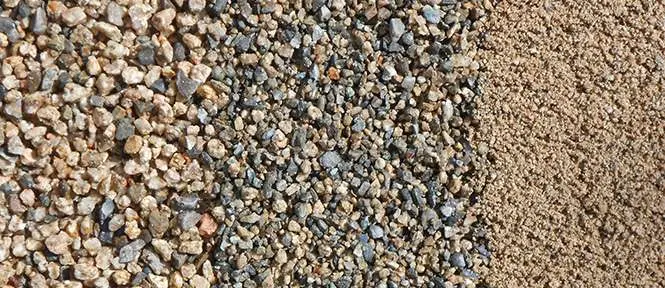Asphalt Maintenance Aggregates
Asphalt Maintenance Aggregates are produced in many forms and serve a variety of needs, but they all share a few common characteristics. Maintenance aggregates are designed to supplement or repair existing pavement, and are typically not designed to be used by themselves. Two of the more common applications, slurry seal and chip seal, are discussed briefly below, along with a number of characteristics that should be considered when selecting asphalt maintenance aggregates. These include:
- size and grading
- cleanliness
- toughness (hardness)
Size and Grading
The maximum size of an aggregate designates the smallest sieve size through which 100 percent of the material will pass. Grading of an aggregate is determined by sieve analysis. Maximum size and grading are controlled by specifications that prescribe the distribution of particle sizes to be used for a particular aggregate material for asphalt mixtures. The distribution of the particle sizes determines the stability and density of the asphalt maintenance mixture. The aggregates for chip seal and slurry seal commonly vary in size from a maximum of 5/8 of an inch to a minimum of ¼ inch with less than 5% passing the No. 4 screen.
Cleanliness
Some aggregates contain foreign or deleterious substances that make them undesirable for asphalt concrete and maintenance mixtures. (Example: clay lumps, shale, organic material, etc.) The sand-equivalent test, is a method of determining the relative proportion of detrimental fine dust or clay-like materials in the portion of aggregate passing the No. 4 (4.75 mm) sieve.
Toughness (Hardness)
Aggregates in this application are subjected to abrasion under traffic loads, and are often used as a wear surface for existing pavements. They must exhibit an ability to resist crushing, degradation, and disintegration. The Los Angeles Abrasion test measures wear abrasion resistance of aggregates.
The principal materials used to create slurry seal are aggregate (rock dust), asphalt emulsion, and filler, which are mixed together according to a laboratory’s design-mix formula. Water is also added for workability. Asphalt emulsions serve as a binder, holding the crushed aggregate together and adhering the new slurry surfacing to the old surface over which it is being applied. The asphalt emulsion is a three-part system consisting of asphalt, water, and emulsifier. Fillers such as Portland cement, hydrated lime, or aluminum sulfate liquid are often used in small quantities as stabilizers or chemical modifiers.
Chip Seal is an application of a bituminous binder covered with an application of clean graded aggregate to an existing asphalt surface. It is also known as armor coat, bituminous sealing or seal coat, to name a few. The binders may be emulsions, paving grade asphalt cements, and modified versions of each being modified with various polymers such as latex, tire and natural rubbers.
If you need any detailed information on our pavement maintenance products, please contact any of our facilities listed on our ‘Locations’ page.



